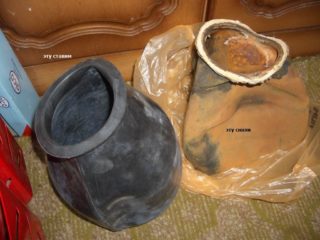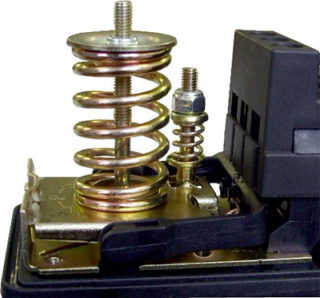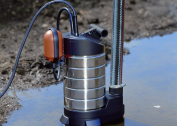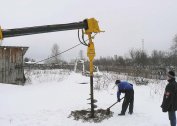Water supply systems in the industrial and domestic sectors work thanks to reliable pumping equipment. But even it can break. In order for the system to start functioning again, it will be necessary to purchase spare parts for water pumping stations, which will make it possible to repair the unit and continue its operation.
The main spare parts for pumping stations
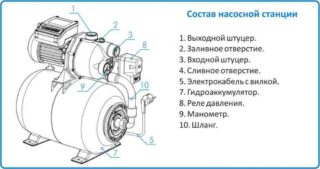 The main components of pumping stations for pumping water from a small depth of pressure devices: the pump itself with a condenser and an electric motor, a check valve, flexible wiring, a hydraulic accumulator, and a control unit.
The main components of pumping stations for pumping water from a small depth of pressure devices: the pump itself with a condenser and an electric motor, a check valve, flexible wiring, a hydraulic accumulator, and a control unit.
The hydraulic accumulator is a metal tank, divided into two parts by a rubber membrane, also called a pear. Water is pumped into it. On the other side of the tank there is a fitting with a nipple through which air is pumped. Under the influence of water, the pear expands, compressing the air behind it. Thanks to this design, the liquid is under pressure, which helps to reduce the number of starts of pumping equipment and extends its life. Flexible piping for the pumping station is required to connect the hydraulic tank and the pressure device.
The check valve is installed on the supply pipe, which is lowered into the well or well. It prevents fluid from spilling back into the source.
Control control devices help maintain a constant pressure in the water supply network. The control unit includes a pressure switch and a pressure gauge. The first device turns the engine on and off, and the second monitors the pressure of the liquid in the network.
What needs to be replaced most often
Spare parts that may cause malfunction or station shutdown:
- Hydraulic tank. Due to its malfunction, the pump operates in jerks.
- Non-return valve. If it fails, the station works non-stop and can burn out.
- Relays and moving parts. If their adjustment is violated, water from the station will flow intermittently.
- Contacts. If they are oxidized or burned, the motor may not start.
- Capacitor. If it breaks down, the equipment will not work, it will buzz.
All these parts require timely replacement as they wear out.
The most frequently failing elements are those that account for the most loads: contacts, filtering elements, diffusers, check valves, pressure switches.
Damage to pressure equipment
The table will give a clear idea of what part needs to be replaced, depending on problems with the station:
| Malfunction | Checked Node | Elimination method |
| Water does not enter the system when the pump is running | Water level at source | Lower the pump and check valve to the desired depth. |
| Check valve | We sort through the filter, clean it. If the part is broken, change. | |
| Fluid in the pipe and impeller chamber | In the absence of water we add. | |
| Pressure switch | We disassemble, check the relay inlet, contacts. We clean. If necessary, change the aperture. | |
| Relay setting | We set the upper and lower pressure limits by means of small and large springs. | |
| Pear | We determine the air pressure, if necessary, put a spare part. | |
| System air | Add water to the impeller chamber. | |
| Noise in the process | Bearings at the pump. | Replace defective parts. |
| Low water pressure in the system | Impeller for wear. | |
| Leaks | The integrity of the rings and cuffs of the fitting elements. |
If it is necessary to replace the bearings, it is better to take the pump to a service center, there they will eliminate the breakdown with a guarantee.In case of leaks due to an activated rubber or a clogged filter on the non-return valve, the malfunction can be completely eliminated independently.
DIY troubleshooting
Methods for troubleshooting at a station with self-replacement of spare parts:
- Power surges in the grid. If they occur regularly, we supply pressure equipment through a stabilizer.
- There is insufficient pressure in the accumulator. We drain water through an open tap and pump air with a car pump up to 1.5–2 atmospheres. Check again.
- The well has a low water level. To confirm this, we take out a suction pipe with a non-return valve, measure the length of the pipe section in the well with a tape measure. We find out the water level. To do this, lower the cord into the well with the saucer tied upside down. As soon as it touches the “mirror”, the stretch will loosen. Compare the length of the pipe and the length of the cord to the water surface. The non-return valve must be three meters below the water “mirror” in the well.
- Suction pipe does not hold water. We disassemble the non-return valve, inspect the guide made of plastic, in case of failure, install a new part. If there is no damage, rinse and install back.
- The pipe that draws in water is not tight. Carefully inspect all connections, sequentially disassembling the element. Check the integrity of the rubber rings, if necessary, change. We carry out an additional leak test by pouring water.
- Air in the pump cavity. Unscrew the cork at the top of the impeller chamber and add water through the funnel until it flows over the edge. We restart the equipment.
- Air exits through an oil seal on the pump shaft. We replace the part by removing the flange on the shaft.
- The membrane is torn. We unscrew the nipple from the air connection of the hydraulic accumulator. If water pours out of it, replace the pear.
The last problem in the stations arises quite often. To replace the membrane, you need to disassemble the tank. Before that, depressurize it, blocking the flow of water and draining residues, then disconnect from the power supply. Further actions are performed in the following sequence:
- weaken the mounting bolts of the flange, drain the water;
- remove the flanges;
- take out the diaphragm;
- we wash the tank;
- insert the membrane into the accumulator;
- straighten the neck and tighten the flange, tightening the bolts from opposite sides;
- We connect to the water supply and electric networks and check the operation of the equipment.
A new membrane for a pumping station costs from 200 rubles and above.
If the diaphragm element is not worn or torn, the air pressure is in compliance with the standards, it is recommended to check the relay. First, the shutdown setting is made. To do this, fully weakening the small one, we reduce the tension of the larger spring until the pressure gauge is 2.5–3.0. We adjust the small spring to turn on the pump, gradually squeezing it. The pressure gauge should show 1.7–1.8. A broken part must be changed. The cost of a new pressure switch is from 200 rubles.
Often, such an element as a diffuser flies in the equipment - the part of the pump that serves to direct the fluid and to convert high-speed water energy into pressure power. The reason for this is the large amount of abrasive impurities in the pumped water. It is easy to change it. It is only necessary to turn off the power and remove the front of the pump. The average cost of a diffuser is 700 rubles.
How to choose accessories
In modern storage tanks, replaceable membranes are most often installed. Sometimes the accumulator is equipped with a fixed diaphragm. The price of such drives is lower. But if the membrane becomes unusable, you will have to completely change the entire tank.
Before buying, you need to make sure that the volume of the pear is suitable for the pressure equipment used, because membranes of a smaller volume than the calculated one will wear out and tear faster. They will often have to be replaced.
When choosing a membrane, you also need to consider the quality of the rubber. It should be dense, strong, without signs of cracks. The strength of the material is important when buying a new diffuser. It, in addition to the diameter, is taken into account when replacing the suction pipe. The best qualities are distinguished by polymer products and crushproof flexible reinforced hoses.
When selecting a pressure switch, it is necessary to take into account the peculiarity of a particular water supply scheme, primarily the indicators of the hydraulic tank and pumping device.
Each water pump is distinguished by design features and the method of connecting spare parts. Parts for some devices are rarely suitable for mounting on other devices. It is very difficult to place the part from the Whirlwind pump on the DAB AQUAJET. Therefore, when choosing a new element, its labeling and characteristics should be studied.
